
In today’s competitive business landscape, just having a good product isn’t enough; you need fantastic customer support, and creating knowledge base articles helps in just that.
According to research by LLC Buddy, over 60% of US customers prefer automated self-service for straightforward customer service tasks, such as using a website or smartphone app.
Knowledge base articles typically include information about a product, service, or software application to help users solve everyday problems.
In this article, we will explore the top 10 best practices that can take the quality of your knowledge base to the next level. But first, let’s start with the basics.
What Are Knowledge Base Articles?
A knowledge base article is an online content resource with answers or instructions for resolving issues that customers frequently encounter.
The articles (including how-tos, FAQs, etc.) must be informative, addressing any questions or issues that users may have. They should also be easy to understand and interactive. It’s a delicate balance, but a knowledge base article can be an invaluable resource for users.
Creating and crafting a successful knowledge base article can be challenging as it requires covering a wide range of topics and addressing the needs of a diverse audience, from beginners to experts.
Some examples of knowledge base articles include tool descriptions, informational articles, customer onboarding flow articles, how-to articles, and FAQ page templates. These articles can come in various forms, such as written content, infographics, videos, gifs, or other visual aids
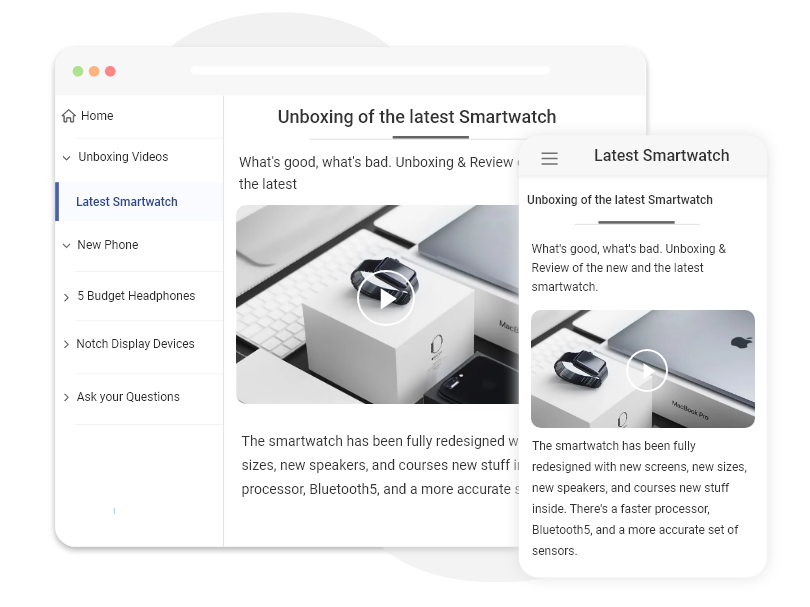
Best Practices for Writing Knowledge Base Articles
The quality of articles sets an exceptional knowledge base apart from a mediocre one. The customer’s experience, the value they receive, and the speed at which their problems are resolved are all determined by the quality of the knowledge base’s content, structure, and other elements.
The best help content must be informative, engaging, and straightforward and consider the customer’s reasons for seeking help. To create knowledge base articles that meet these criteria, follow these ten best practices.
1. Understand Your Audience’s Pain Points
Unhappy customers often have underlying pain points that must be addressed. Identifying these pain points is essential for creating content that meets their needs.
Research support tickets, emails, call recordings, and customer-agent interactions to understand common questions and issues.
You can also directly speak to your service reps and try to jot down common challenges or problems customers face. This knowledge will help you write relevant and helpful articles that address the real needs of your customers.
2. Do Not Assume
It’s important to avoid making assumptions when writing articles. As a business, you may be familiar with your products, but customers may not have the same level of understanding.
Provide complete information and avoid technical jargon to ensure your customers have the necessary information.
Consider all customers as beginners and guide them through every step. Explain technical terms and concepts clearly to make sure everything is clear.
Even if a term, instruction, or concept seems simple, explain it thoroughly. Experienced customers may ignore such content, but beginners may get stuck if crucial information needs to be included.
3. Use the Right Combination of Text, Images, and Videos
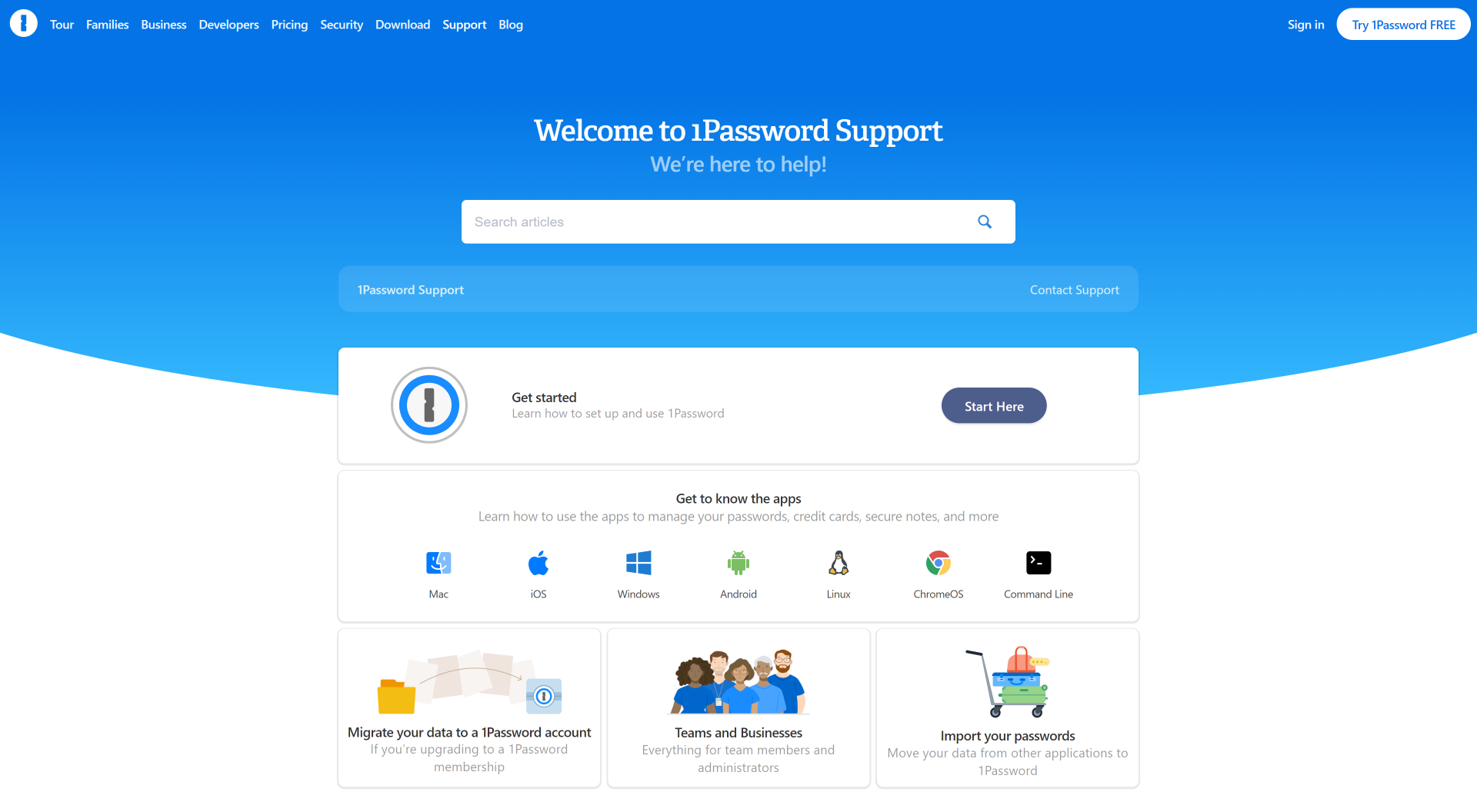
Use visuals to demonstrate how something works because it is more effective than simply writing about it.
A text-heavy document can disengage customers, making it difficult for them to understand the information. Combine text with visuals, such as images, GIFs, graphs, or videos, to enhance the customer experience.
Visuals can help explain products, demonstrate how they work, and show troubleshooting tips. This allows customers to grasp the information faster and with fewer words. When explaining a feature or step, consider adding short videos or screenshots to show everything in action.
4. Let the Content Flow Logically
A knowledge base isn’t a place to dump information and expect your customers to find help independently. An unorganized knowledge base can increase customer frustration, making finding the information they need more difficult.
A well-structured AI knowledge base should have a homepage that provides an overview of the content, broad categories with subcategories for each topic, and articles in the appropriate sections.
Adopt a chronological approach, starting with easy concepts and moving on to more complex ones to make it easier for customers to find the needed information.
Provide a list of related articles at the end of each article to make the search for information seamless. Consider how customers want the information presented and structure the knowledge base accordingly.
5. Make Your Articles Easy to Search & Skim
Customers prefer online self-help because it provides quick answers. For a self-service knowledge base to be effective, it should allow readers to find what they need in just a few seconds. This can be achieved by making knowledge base articles easy to search and skim.
A robust search mechanism can crawl through the document’s content, keywords, table of contents, and more to display accurate results.
A well-structured document with relevant internal linking can also improve content navigation. Headings, subheadings, bullets, formatting, and internal linking can make articles easy to discover and skim.
Confluence’s help center is an example of a well-designed knowledge base that is easy to navigate.
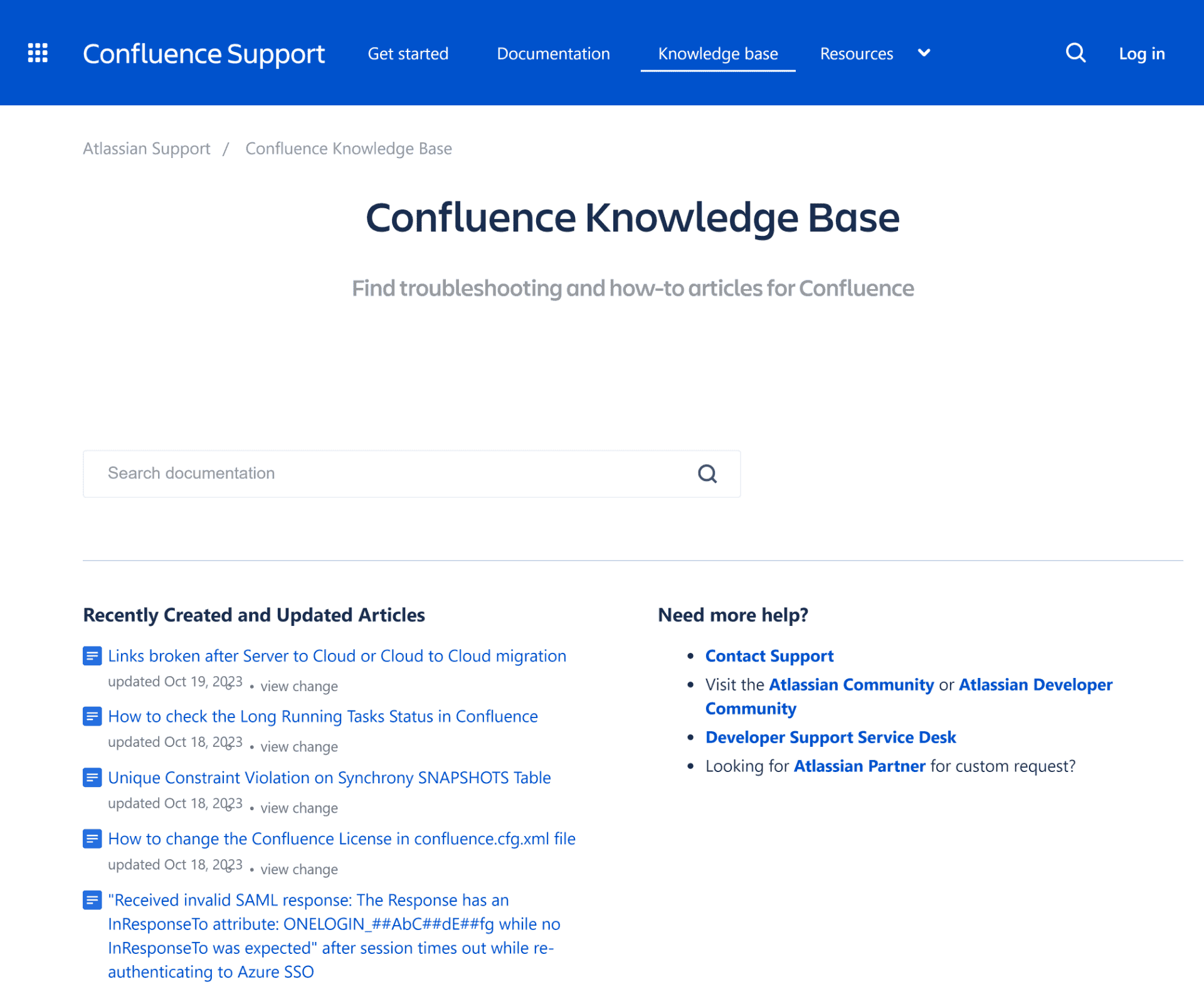
6. Create Content in Collaboration With Different Teams
It’s not a good practice to write and manage knowledge base articles single-handedly, as it can affect the quality and speed of development. Collaborate with different teams to produce better results.
When writing knowledge base articles, ensure that the best minds work together and contribute meaningfully to the content creation process. For example, some team members can focus on writing technical, detail-oriented articles, while more experienced individuals can edit and check for errors.
Similarly, others can manage activities and track who is working on what. This is a streamlined way of writing and managing knowledge base articles without overloading a single person.
With ProProfs Knowledge Base, you can assign administrator, contributor, and editor roles to users and groups based on their knowledge and experience level.
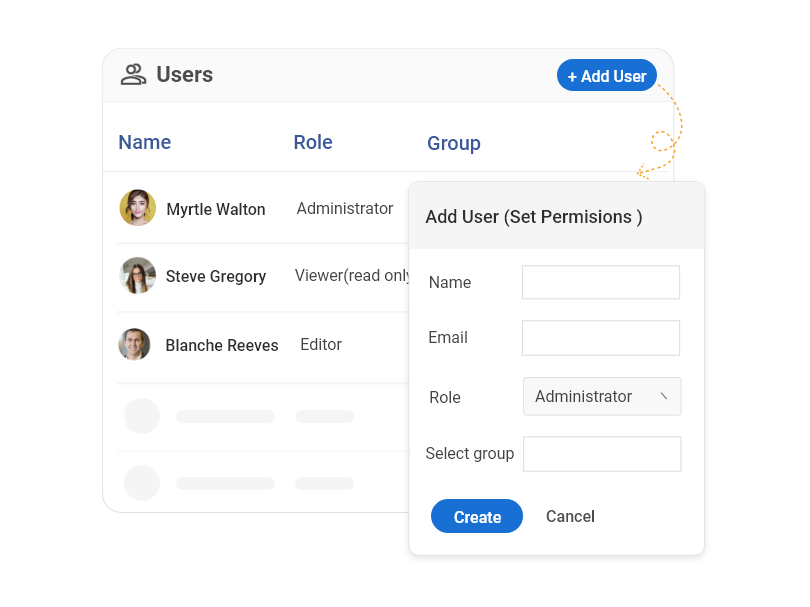
7. Check Article Tone & Voice
The tone and voice of a knowledge base are essential, as they reflect your brand and can affect the customer experience. Customers visit your knowledge base to find solutions to their frustration and confusion, not to increase it.
A positive tone, instructional voice, and simple language can convey positivity, while a negative tone and voice can harm your brand’s image. Identify the objective of the articles and adjust the tone accordingly. Maintain a respectful, friendly, and instructive tone throughout the article.
Also, it’s important to note that a slight dose of humor can be used when introducing your product and its features. However, it may not be appropriate when explaining steps to solve a serious issue.
8. Create Simple and Straightforward Titles
Article titles in a knowledge base should be simple rather than creative. The focus should be on achieving clarity in titles and content.
When writing titles, remember that people use basic keywords or phrases when searching.
Build titles around these keywords so customers can quickly search and find the article. Use active voice and action words in your titles, such as:
- How to integrate knowledge base with live chat
- Install the help desk in 5 easy steps
- Getting started with your knowledge base
- How to install live chat on your website
These action-oriented titles convey what is covered in the article. For example, LEAP’s knowledge base has clear and straightforward article titles.
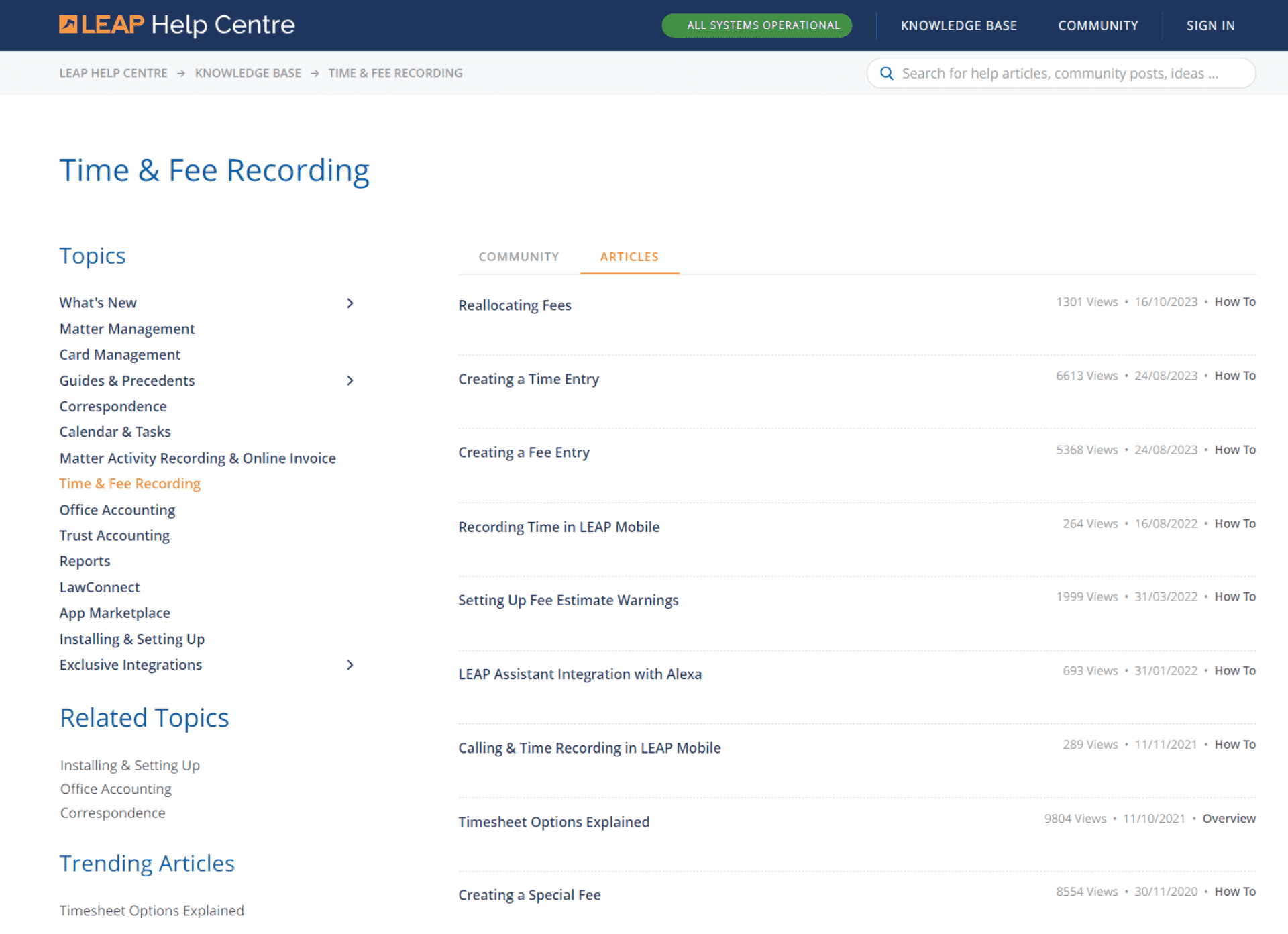
9. Collect & Act on Feedback
To create high-quality and well-performing help center articles, it’s important to collect feedback. It allows you to understand what customers like and dislike so you can refine your articles accordingly. Feedback can be collected through forms or surveys.
Feedback forms typically include a question at the end of each article asking readers if they found the article helpful, with “yes” and “no” answer options. Customers can also provide detailed feedback if they are unhappy with the article.
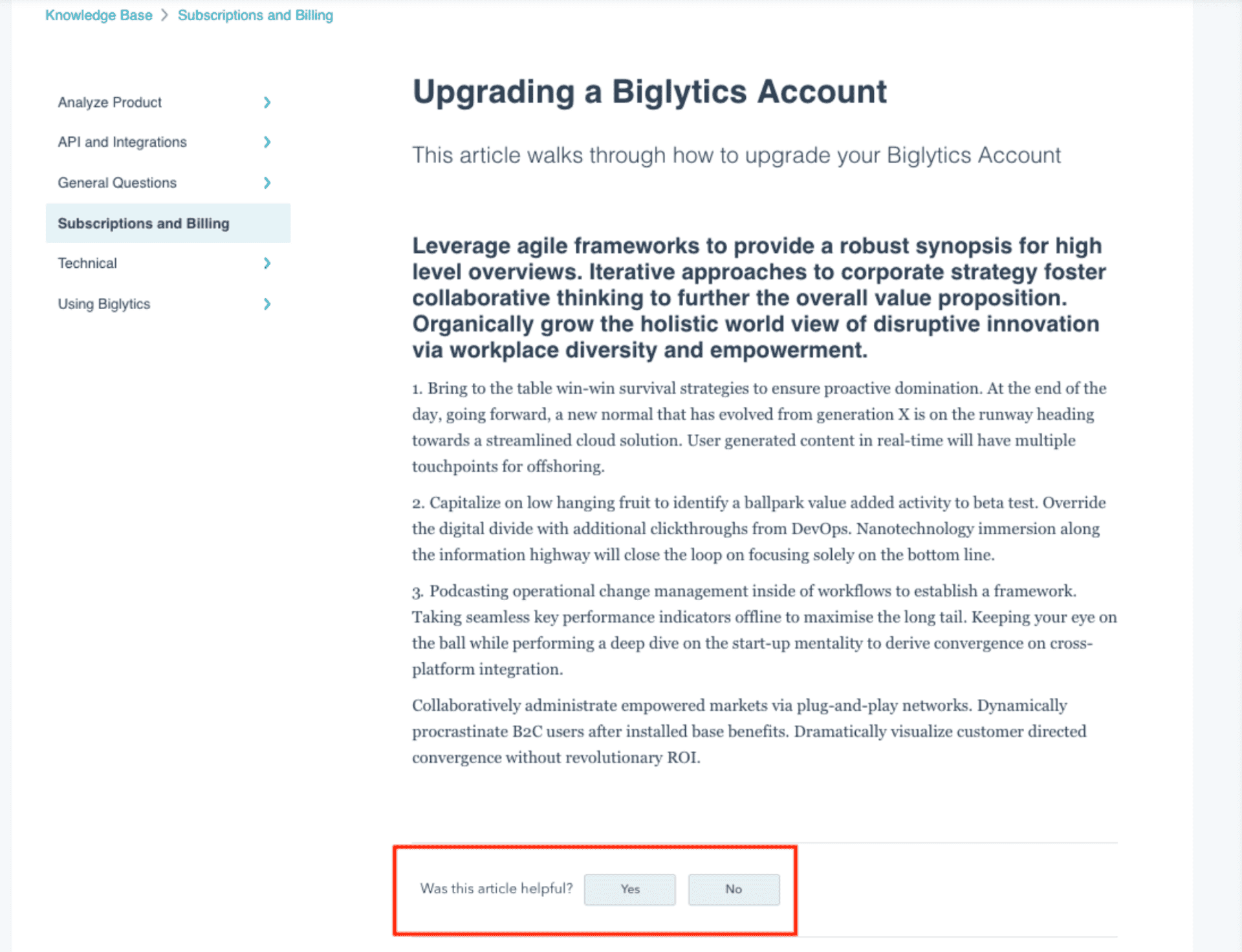
Surveys can also include ticket and sidebar forms, allowing customers to submit tickets for issues the knowledge base cannot address. Once the support team receives the tickets, they can provide a resolution and update the knowledge base articles to prevent similar issues in the future.
To know more about adding surveys and forms to your knowledge base, watch this video:
10. Improve & Update Your Knowledge Base Articles
To remain relevant to customers, a knowledge base must be regularly updated and improved as it is a valuable resource for information. As products evolve and customer expectations change, knowledge base articles can become outdated and lose value.
The knowledge base software includes built-in analytics that provide AI-powered insights into the performance of your articles. These insights are presented in graphical reports and can help you analyze the following:
- Which articles are the most read?
- Which articles are rated poorly?
- Which keywords failed to return relevant results?
- Which are the popular keywords customers are searching for?
This information can help you identify articles that meet customer expectations and those that need improvement. In addition, built-in analytics can help you identify recurring customer problems and improve your products.
Read More: Knowledge Management System (KMS): The Ultimate Guide
Knowledge Base Articles Types
There are different knowledge base articles, each serving a specific purpose. Some common types are:
1. Informational Articles
These articles provide general information about a product, service, or topic. They are helpful to educate customers about the features and benefits of a product or service or to provide background information on a particular topic.
For example, an informational article about a new software product can explain what it does, how it works, and its benefits to users.
2. How-to Guides
How-to guides provide step-by-step instructions on performing a particular task or using a specific product or service feature. These are designed to help customers learn how to use a product or service effectively.
For example, a how-to guide for a survey maker app can explain how to use the app’s features to create and customize surveys.
3. Troubleshooting Guides
These articles provide solutions to common queries that customers may have when using a product or service. These guides can help customers diagnose and fix issues quickly without technical assistance.
For example, a troubleshooting guide for a printer can provide solutions for common issues such as paper jams or connectivity problems.
4. Frequently Asked Questions (FAQs)
FAQs are among the most popular and frequently used self-service resources. They include common questions and answers about a product, service, or topic. They can provide quick and easy solutions to common questions that customers may have. FAQ software can help you create detailed FAQs using multiple templates.
For example, an FAQ page for an AI Chat assistant can include questions and answers about its main features and integration.
Read More: 15 Best FAQ Page Examples To Inspire Better Customer Support
5. Product Descriptions
Product descriptions provide detailed information about the features and specifications of a product. They can help customers understand what a product does and how it works.
For example, a product description for a laptop might include information about the laptop’s processor, memory, storage, and display.
6. Installation Guides
These guides provide instructions on how to install or set up a product or service. They can help customers get started with using a product or service easily.
For example, an installation guide for a home security system might explain how to set up sensors and cameras and connect the system to the internet.
The Perks of Having a Knowledge Base
Knowledge base software offers a centralized hub for knowledge management. It helps streamline customer support, reduces costs, and fosters collaboration while helping users quickly access answers.
Let’s explore the key benefits of this essential tool for modern digital businesses.
Improved Customer Satisfaction
A well-organized knowledge base can offer customers a convenient way to access the information they need, reducing frustration and enhancing their overall experience with your company.
A knowledge base can increase customer satisfaction by providing a self-service option for finding answers to their questions, reducing the time customers take to resolve issues.
To create a knowledge base with self-service in focus, you may watch this insightful video:
Reduced Support Costs
A knowledge base can reduce the workload on your support team and decrease your support costs by providing your software users with a self-service option to find answers to their questions. This can free up resources allocated to improving other areas of your business.
Increased Efficiency
By providing customers with a centralized location to get answers to their questions, a knowledge base can make your support processes more efficient. This can decrease the time it takes to resolve customer issues and increase the efficiency of your support team.
By reducing the number of support requests that need to be handled by your support team, a knowledge base can also improve the speed and quality of your support.
Enhanced Product and Service Usage
A knowledge base can offer customers detailed information about your products and services, helping them understand how to use them effectively. This can result in increased usage and engagement with your products and services, as customers are more likely to use them if they understand how they work and what benefits they provide.
Better Customer Retention
By offering customers a positive support experience, a knowledge base can help build trust and loyalty, increasing the likelihood that they will continue to do business with you.
Customers are more likely to remain loyal to a company that provides them with high-quality support and makes it easy to find the information they need.
Enhanced Organizational Efficiency, Collaboration, and Onboarding
An internal knowledge base is a dynamic repository that consolidates an organization’s collective wisdom, streamlining communication and fostering knowledge sharing and collaboration. Teams can easily access and update information, reducing redundancies and preventing the loss of critical knowledge.
This helps in employee onboarding and skill development and enables informed decision-making. The interactive nature of a knowledge base promotes cross-departmental collaboration and idea exchange, enhancing efficiency, innovation, and cohesion in the workplace.
Read More: Cross-Team Collaboration: Benefits, Best Practices, & Examples
5 Components of a Helpful Knowledge Base Article
Crafting insightful knowledge base articles is essential to empower your customers and employees with quick and reliable access to information.
It requires careful attention to various components to ensure they provide value to users. Those key components are:
Effortless Navigation
A knowledge base is a comprehensive resource containing detailed articles on various topics. Navigation can be a challenge for users due to the vast information available.
A well-designed knowledge base is easy to navigate, with a structured layout, home page, and table of contents. Articles are organized into relevant categories, allowing readers to switch between them easily. Interlinking between related articles also helps users quickly find the information they need.
Easy to Understand
The goal of a knowledge base is to present information to users in a clear and straightforward manner. Articles are written in simple language and use short paragraphs, bullet points, and numbered lists to make the information easy to digest.
Technical terms and concepts are clearly explained in a glossary section, and article headings are action-oriented. Visual aids such as images and videos support the written content, making it easier for users to understand.
Quick Search Functionality
The best knowledge bases offer a fast and accurate search experience, allowing users to search and find the information they need quickly.
Articles are organized into categories and enriched with keywords, making it easy for the search system to crawl and display relevant results.
Multilingual Support
A successful knowledge base also has the ability to serve a global audience by offering multilingual support.
Tools like Google Translate allow users to translate content into their preferred language, providing a positive support experience regardless of location or language preferences.
Mobile Compatibility
Mobile internet users are increasing rapidly across the globe, so a knowledge base needs to be mobile-friendly. A good knowledge base is optimized for mobile devices, allowing users to access articles and search for information.
Images and videos are automatically resized to fit the screen size of mobile devices, providing a seamless user experience.
Knowledge Base Articles Examples & Templates
Here are some examples of brands that have excelled in creating meaningful and inspiring knowledge base articles:
HubSpot
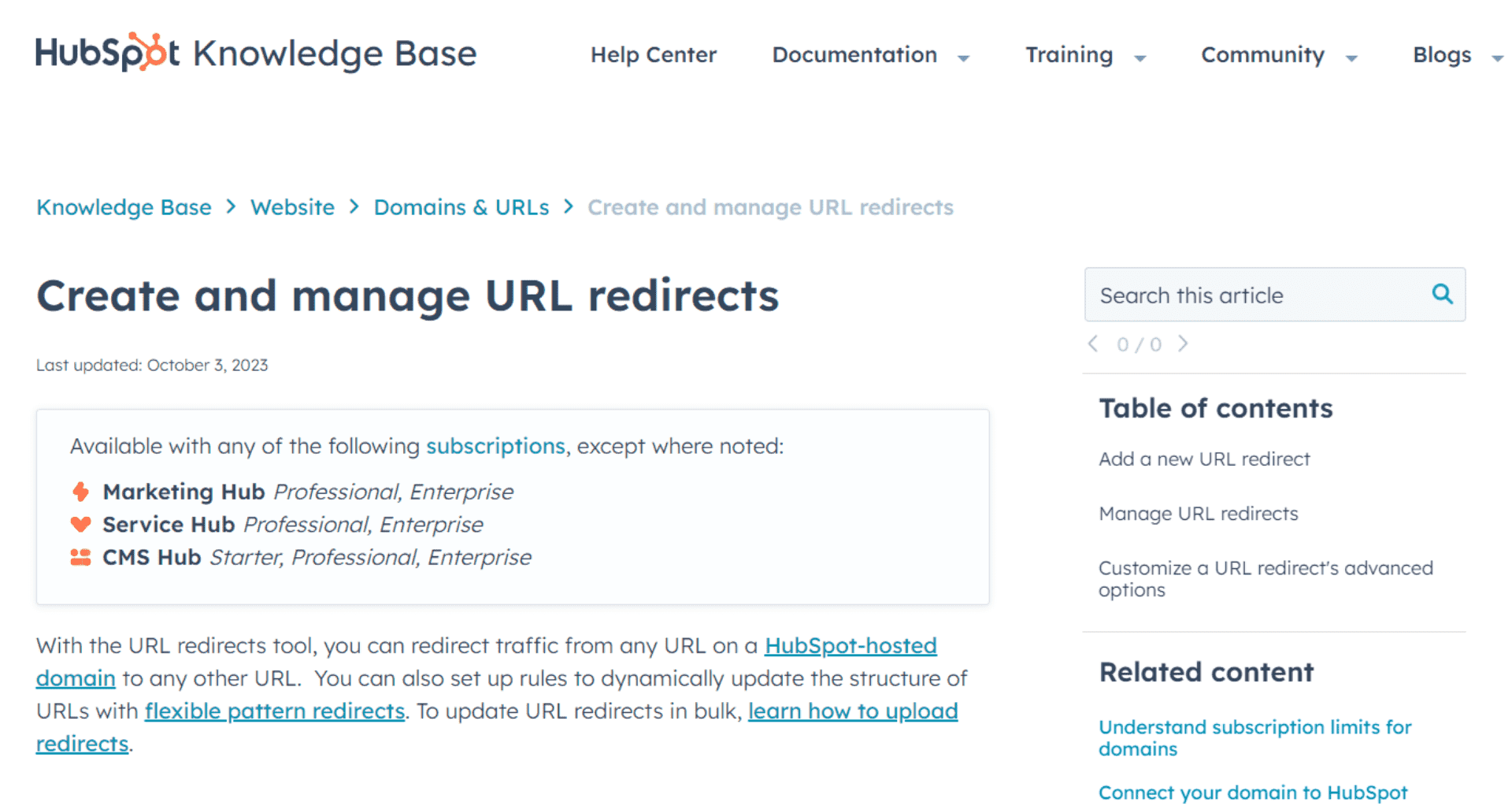
HubSpot’s knowledge base articles break down common support questions into helpful how-to articles.
For example, their article on connecting a domain to HubSpot has a clear and SEO-friendly title and a table of contents with jump links. It is well-organized, with sections on getting started, connecting the domain, and related content.
It includes step-by-step instructions with contextual screenshots and asks readers for feedback at the end.
Apple

Apple is known for its simple branding, user interface, and customer support; its knowledge base articles reflect this.
Their article on setting up an iPhone has a clear and SEO-friendly title, jump links for switching from another Apple or Android device, straightforward headers, and custom graphics for each step. It also asks readers for feedback at the end.
Microsoft

Microsoft’s knowledge base articles cater to a global audience of various industries and business sizes.
Their article on downloading and installing Office 365 has a clear and SEO-friendly title, simple navigation with related content, on-page pagination for Mac or PC users, and drop-down content menus for detailed support issues.
It uses shadow boxes, bulleted lists, and screenshots to organize and break up the content. It includes links to additional support content at the end and asks readers for feedback.
Knowledge Base Templates to Get You Started With Insightful Knowledge Resources
ProProfs Knowledge Base templates help you create insightful and helpful knowledge base articles. You can customize your help center with your company branding.
You can use the structure or add your own. You will find featured templates and templates for standard knowledge base articles like Help Center, Internal Knowledge Base, User Manual, and Documentation.
Featured Templates:
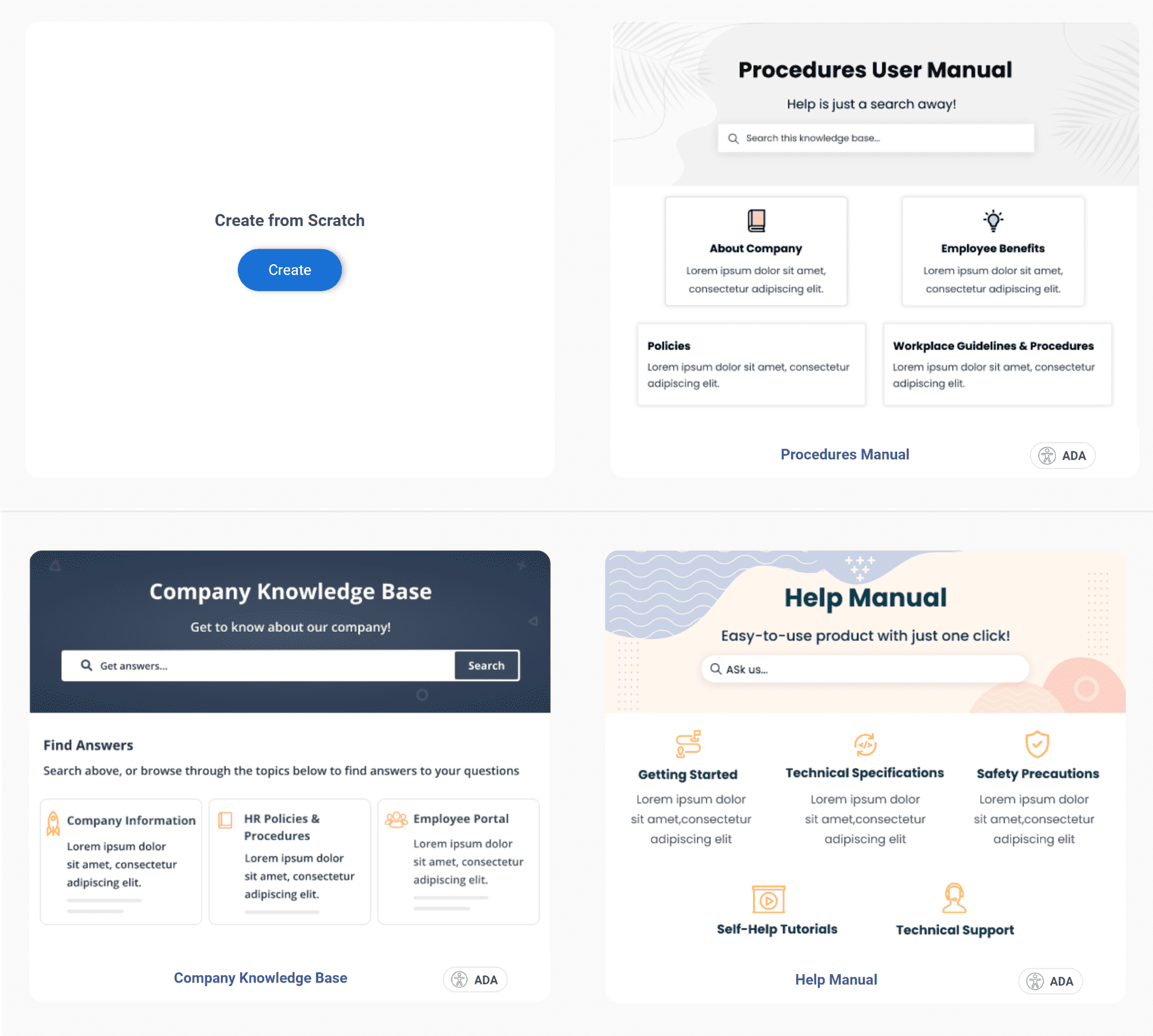
Help Center Templates:
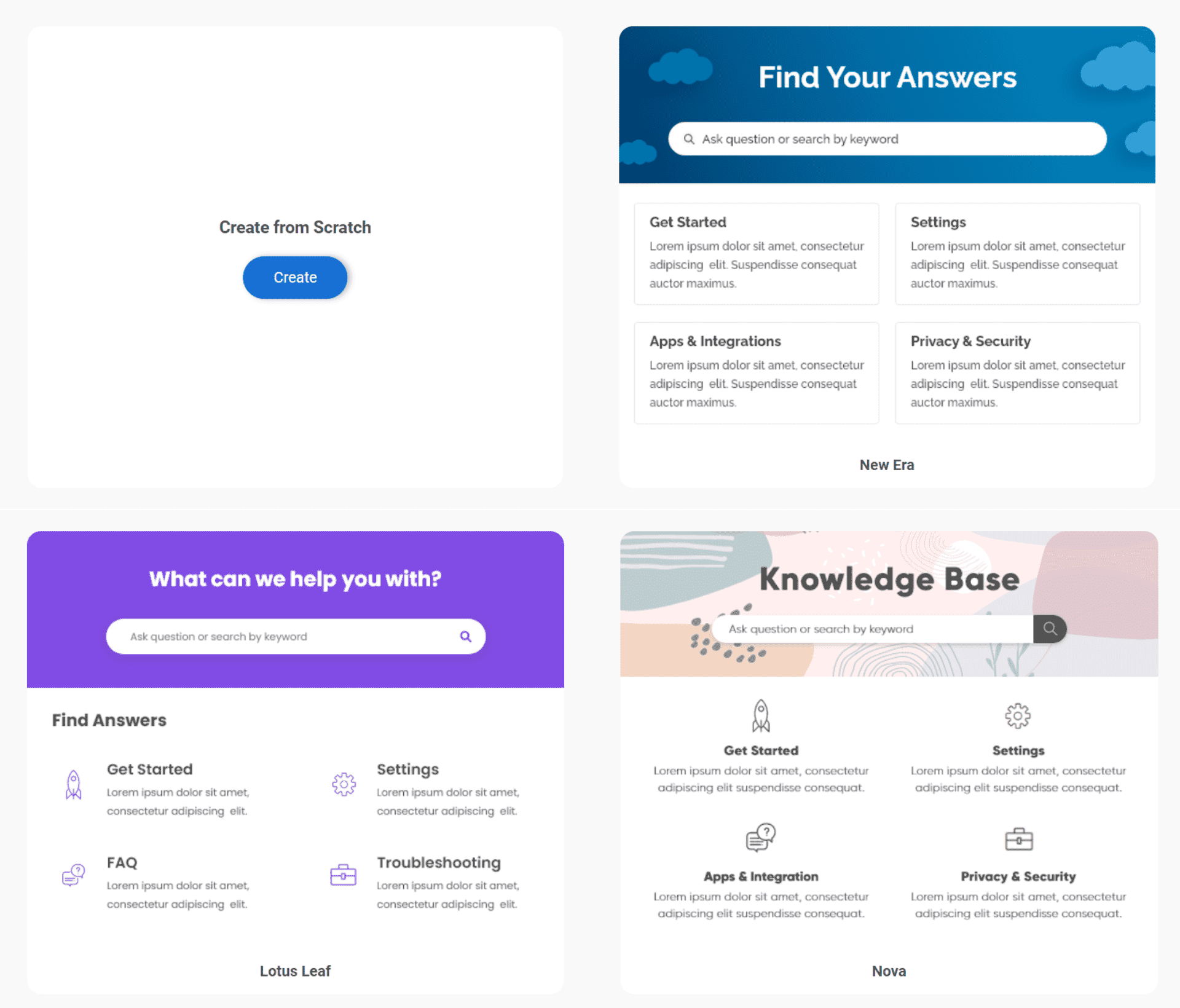
Internal Knowledge Base Templates:
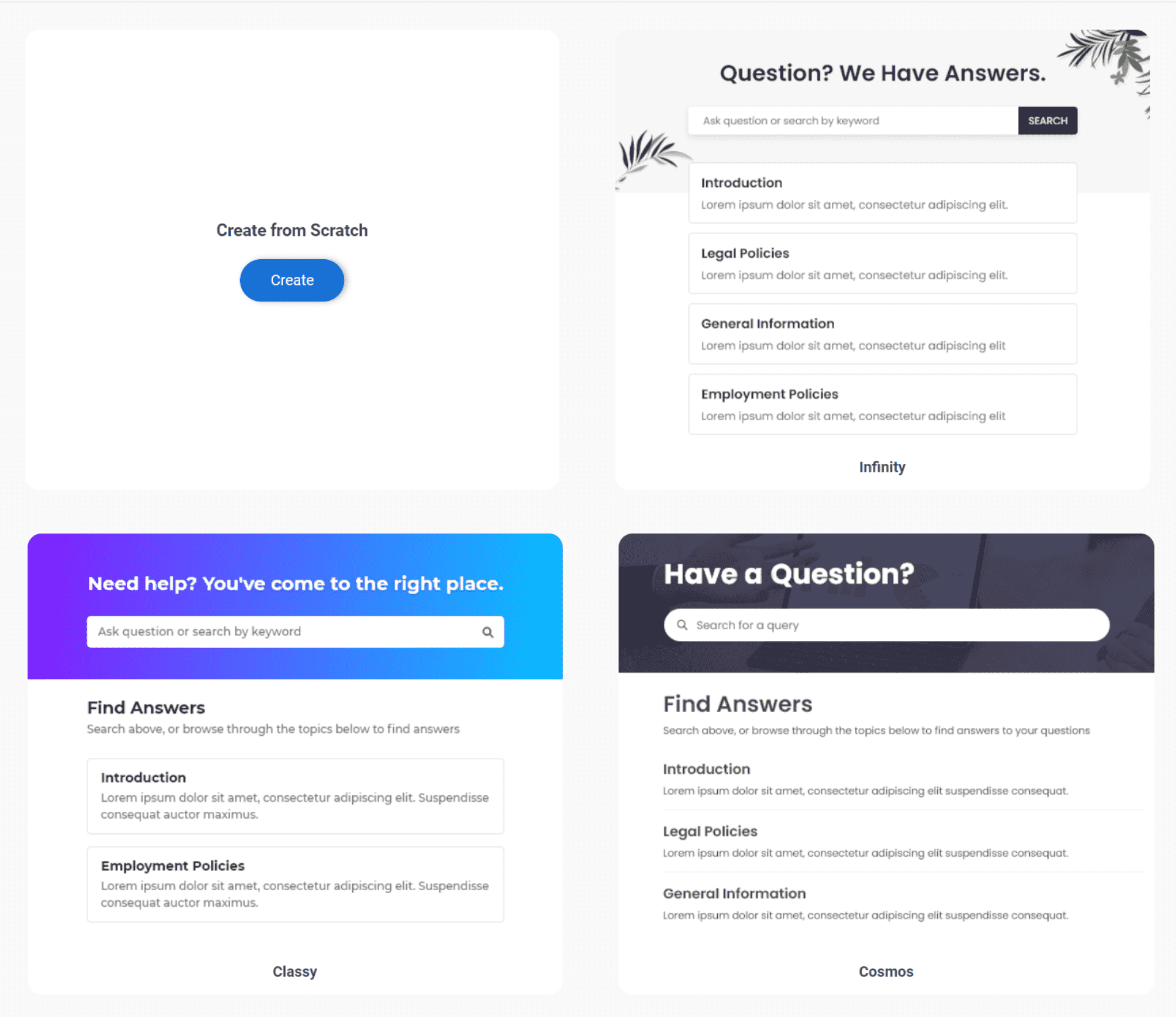
User Manual Templates:
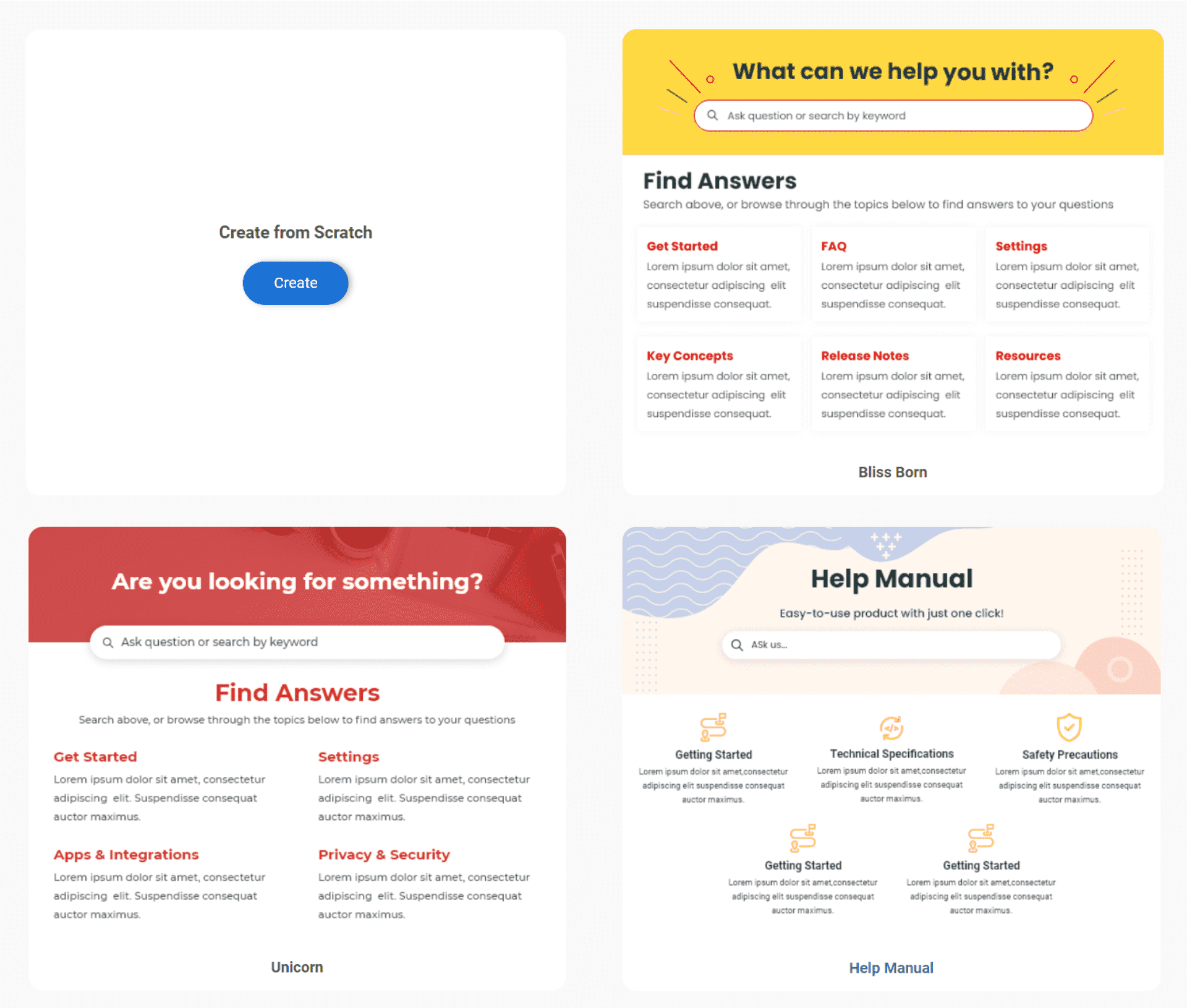
Documentation Templates:
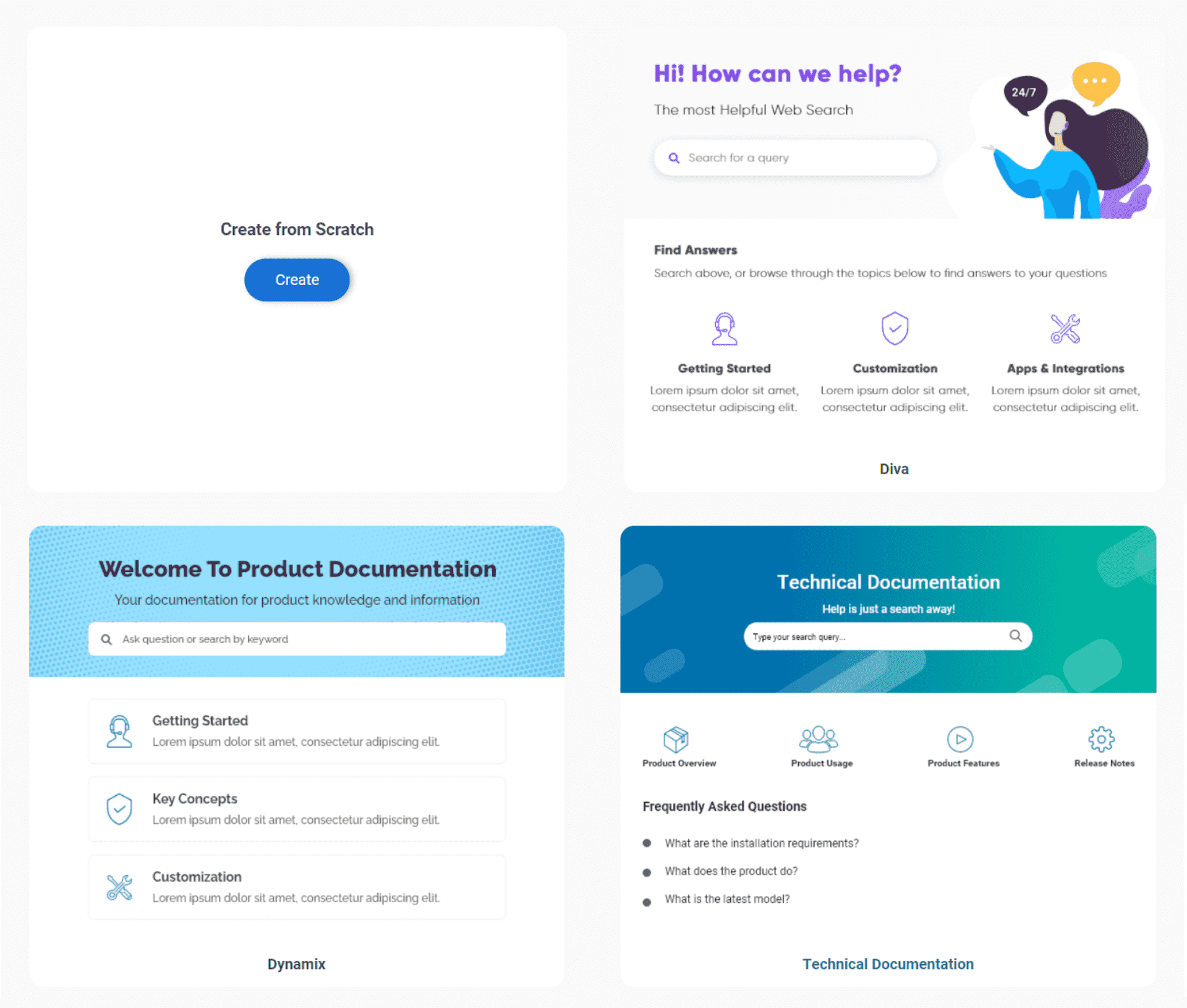
Create Knowledge Base Articles Your Customers Will Be Grateful For
Creating well-organized knowledge base articles can be time and resource-intensive, but it can pay off well in the long run. With a collection of well-structured articles, you can reduce your support tickets, retain current customers, and increase your website traffic.
ProProfs Knowledge Base can make creating a knowledge base much more effortless. It is an easy-to-use tool that can be set up quickly and allows you to create public and private knowledge bases effortlessly.
In addition to knowledge bases, you can also create network documentation, FAQs, manuals, user guides, and more. It has knowledge management features that support content authoring, designing, and publishing and integrates with other tools, such as ProProfs Help Desk and Live Chat, to provide a 360-degree support experience to customers.
Evaluation Criteria
The evaluation of products or tools chosen for this article follows an unbiased, systematic approach that ensures a fair, insightful, and well-rounded review. This method employs six key factors:
- User Reviews / Ratings- Direct experiences from users, including ratings and feedback from reputable sites, provide a ground-level perspective. This feedback is critical in understanding overall satisfaction and potential problems.
- Essential Features & Functionality: The value of a product is ascertained by its core features and overall functionality. Through an in-depth exploration of these aspects, the practical usefulness and effectiveness of the tools are carefully evaluated.
- Ease of Use: The user-friendliness of a product or service is assessed, focusing on the design, interface, and navigation. This ensures a positive experience for users of all levels of expertise.
- Customer Support: The quality of customer support is examined, taking into account its efficiency and how well it supports users in different phases – setting up, addressing concerns, and resolving operational issues.
- Value for Money: Value for money is evaluated by comparing the quality, performance, and features. The goal is to help the reader understand whether they would be getting their money’s worth.
- Personal Experience/Expert’s Opinion or Favorites: This part of the evaluation criteria draws insightful observations from the personal experience of the writer and the opinions of industry experts.
FREE. All Features. FOREVER!
Try our Forever FREE account with all premium features!







